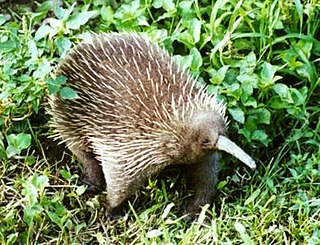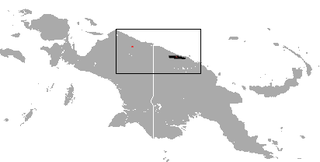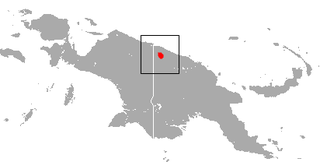
Tok Pisin, often referred to by English speakers as New Guinea Pidgin or simply Pidgin, is a creole language spoken throughout Papua New Guinea. It is an official language of Papua New Guinea and the most widely used language in the country. However, in parts of the southern provinces of Western, Gulf, Central, Oro, and Milne Bay, the use of Tok Pisin has a shorter history and is less universal, especially among older people.

Mary Flannery O'Connor was an American novelist, short story writer and essayist. She wrote two novels and 31 short stories, as well as a number of reviews and commentaries.

"Pigs Is Pigs" is a story by American writer Ellis Parker Butler. First published as a short story in American Illustrated Magazine in September 1905, "Pigs Is Pigs" went on to dozens of printings as a book and in anthologies over the next several decades.

The long-beaked echidnas make up one of the two extant genera of echidnas, spiny monotremes that live in New Guinea; the other being the short-beaked echidna. There are three living species and one extinct species in this genus. The extinct species were present in Australia. Echidnas are one of the two types of mammals that lay eggs, the other being the platypus. The echidnas retain reptilian features such as egg-laying but display mammalian features such as fur and lactation.

The dingiso, also known as the bondegezou, is an endangered, long-tailed marsupial found only in mountain forests on the west of the island of New Guinea. It is a species of tree-kangaroo, which are mammals native to Australia and New Guinea that feed on leaves or other plant matter. It belongs to the macropodid family (Macropodidae) with kangaroos, and carries its young in a pouch like most other marsupials. Though sacred to the local Moni people, it is still threatened by hunting and habitat loss.

The New Guinea singing dog or New Guinea Highland dog is an ancient (basal) lineage of dog found in the New Guinea Highlands, on the island of New Guinea. Once considered to be a separate species in its own right, under the name Canis hallstromi, it is closely related to the Australian dingo. The dog is unique among canines, as it is one of the few to be considered "barkless", and known for its unusual "yodel"-like style of vocalizing.

Timothy Fridtjof Flannery is an Australian mammalogist, palaeontologist, environmentalist, conservationist, explorer, author, science communicator, activist and public scientist. He was awarded Australian of the Year in 2007 for his work and advocacy on environmental issues.

Sir David's long-beaked echidna, also known as Attenborough's long-beaked echidna or the Cyclops long-beaked echidna, is one of the three species from the genus Zaglossus that occurs in New Guinea. It is named in honour of naturalist Sir David Attenborough. It lives in the Cyclops Mountains, which are near the cities of Sentani and Jayapura in the Indonesian province of Papua.

The eastern long-beaked echidna, also known as Barton's long-beaked echidna, is one of three species from the genus Zaglossus to occur in New Guinea. It is found mainly in the eastern half at elevations between 2,000 and 3,000 metres.

The Telefomin cuscus is a critically endangered possum found on New Guinea.

Mamo or woowoo is a common name for two species of extinct birds. Together with the extant ʻIʻiwi they make up the genus Drepanis. These nectarivorous finches were endemic to Hawaii but are now extinct.

The golden-mantled tree-kangaroo is a critically endangered, furry, bear-like mammal found only in mountain rain forests on the island of New Guinea. Like other tree-kangaroos, it lives in trees and feeds on plant matter. It belongs to the macropod family (Macropodidae) with kangaroos, and carries its young in a pouch like other marsupials. The range is restricted to two small mountain areas in the north and it is threatened by hunting and habitat loss.

The Weather Makers: The History and Future Impact of Climate Change is a 2005 book by Australian scientist Tim Flannery. It discusses climate change, its scientific basis and effects, and potential solutions.

Timothy Earl Flannery is a former Major League Baseball player who spent 11 seasons with the San Diego Padres, from 1979 to 1989. He was the third base coach of the San Francisco Giants from 2007 to 2014. He is the nephew of former Major League Baseball player Hal Smith.

The grizzled tree-kangaroo is a furry, long-tailed, bear-like mammal native to tropical rainforests on the island of New Guinea. Like most tree-kangaroos, it lives in trees and eats leaves, fruit, and bark. It is a member of the macropod family Macropodidae with kangaroos, and carries its young in a pouch like other marsupials. The tree-kangaroo is uncommon and threatened by hunting and habitat loss. It is found in foothill forests of northern and western New Guinea and is indigenous to some of the offshore islands.

Hill's roundleaf bat is a species of bat in the family Hipposideridae endemic to Papua New Guinea.

Hulitherium tomasetti is an extinct zygomaturine marsupial that lived in New Guinea during the Pleistocene. The species name honours Berard Tomasetti, a Catholic priest in Papua New Guinea, who brought the fossils to the attention of experts.
Ilaria is an extinct genus of marsupial of the family Ilariidae, dating from the Late Oligocene of South Australia. Its diet consisted of leaves.
The Moni are an indigenous people in the Indonesian Paniai regency (kabupaten) of Central Papua in Western New Guinea. They speak the Moni language.
Alexandra Szalay is an Australian anthropologist and mammalogist, who specialises in the study of Papua New Guinea. The Gebe cuscus is named after her.

















